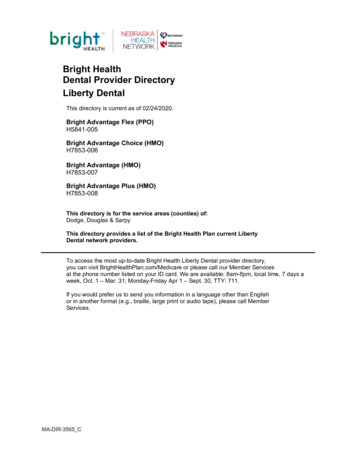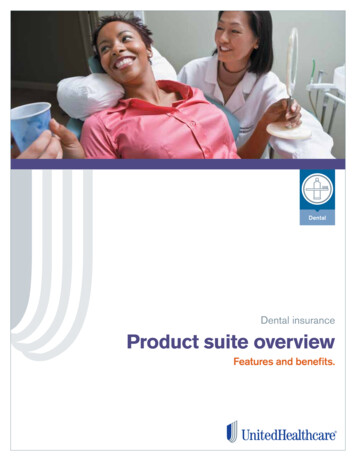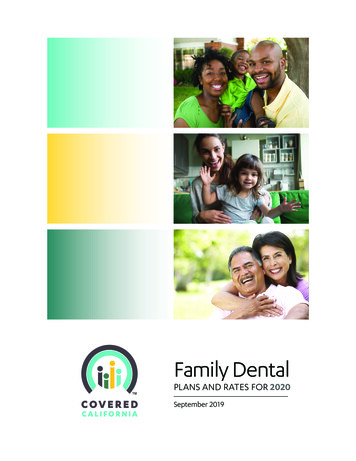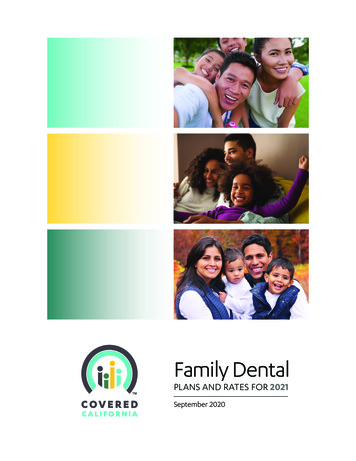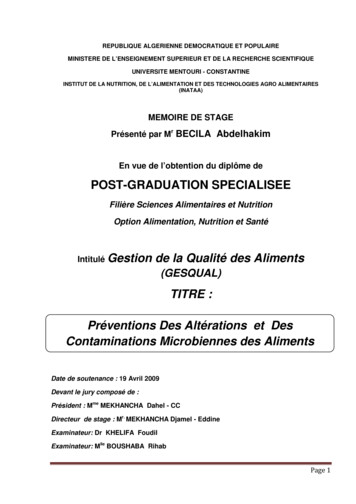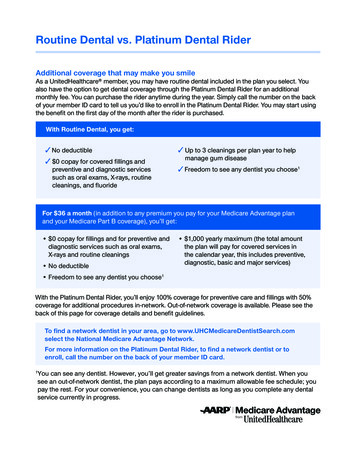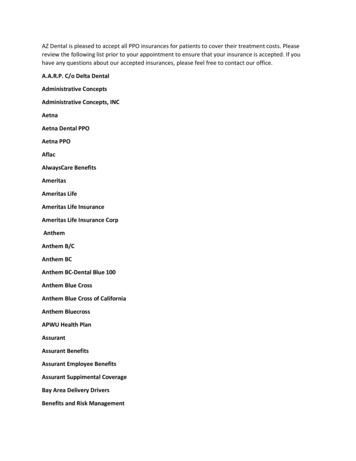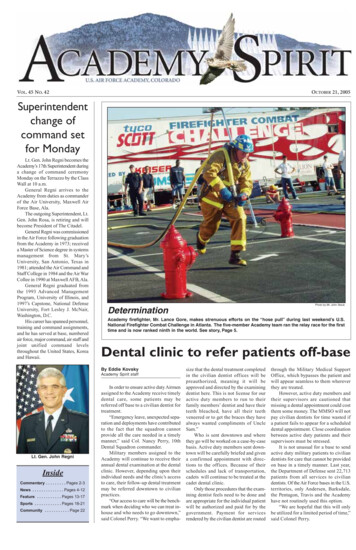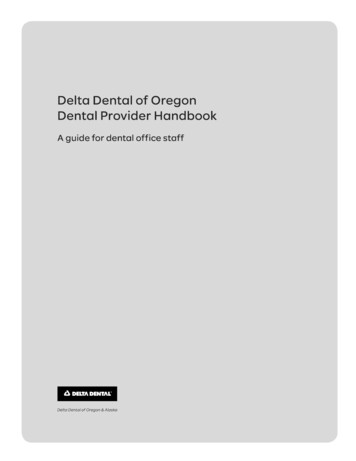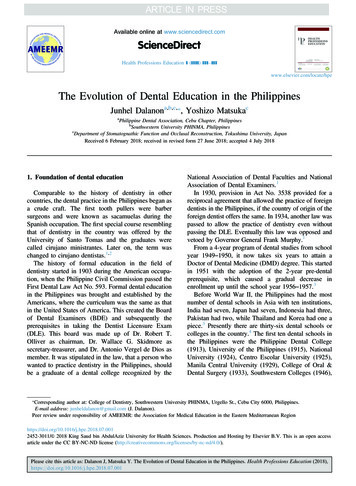
Transcription
Available online at www.sciencedirect.comHealth Professions Education ] (]]]]) ]]]–]]]www.elsevier.com/locate/hpeThe Evolution of Dental Education in the PhilippinesJunhel Dalanona,b,c,⁎, Yoshizo MatsukacaPhilippine Dental Association, Cebu Chapter, PhilippinesbSouthwestern University PHINMA, PhilippinescDepartment of Stomatognathic Function and Occlusal Reconstruction, Tokushima University, JapanReceived 6 February 2018; received in revised form 27 June 2018; accepted 4 July 20181. Foundation of dental educationComparable to the history of dentistry in othercountries, the dental practice in the Philippines began asa crude craft. The first tooth pullers were barbersurgeons and were known as sacamuelas during theSpanish occupation. The first special course resemblingthat of dentistry in the country was offered by theUniversity of Santo Tomas and the graduates werecalled cirujano ministrantes. Later on, the term waschanged to cirujano dentistas.1,2The history of formal education in the field ofdentistry started in 1903 during the American occupation, when the Philippine Civil Commission passed theFirst Dental Law Act No. 593. Formal dental educationin the Philippines was brought and established by theAmericans, where the curriculum was the same as thatin the United States of America. This created the Boardof Dental Examiners (BDE) and subsequently theprerequisites in taking the Dentist Licensure Exam(DLE). This board was made up of Dr. Robert T.Olliver as chairman, Dr. Wallace G. Skidmore assecretary-treasurer, and Dr. Antonio Vergel de Dios asmember. It was stipulated in the law, that a person whowanted to practice dentistry in the Philippines, shouldbe a graduate of a dental college recognized by theNational Association of Dental Faculties and NationalAssociation of Dental Examiners.1In 1930, provision in Act No. 3538 provided for areciprocal agreement that allowed the practice of foreigndentists in the Philippines, if the country of origin of theforeign dentist offers the same. In 1934, another law waspassed to allow the practice of dentistry even withoutpassing the DLE. Eventually this law was opposed andvetoed by Governor General Frank Murphy.1From a 4-year program of dental studies from schoolyear 1949–1950, it now takes six years to attain aDoctor of Dental Medicine (DMD) degree. This startedin 1951 with the adoption of the 2-year pre-dentalprerequisite, which caused a gradual decrease inenrollment up until the school year 1956–1957.3Before World War II, the Philippines had the mostnumber of dental schools in Asia with ten institutions,India had seven, Japan had seven, Indonesia had three,Pakistan had two, while Thailand and Korea had one apiece.3 Presently there are thirty-six dental schools orcolleges in the country.4 The first ten dental schools inthe Philippines were the Philippine Dental College(1913), University of the Philippines (1915), NationalUniversity (1924), Centro Escolar University (1925),Manila Central University (1929), College of Oral &Dental Surgery (1933), Southwestern Colleges (1946),⁎Corresponding author at: College of Dentistry, Southwestern University PHINMA, Urgello St., Cebu City 6000, Philippines.E-mail address: junheldalanon@gmail.com (J. Dalanon).Peer review under responsibility of AMEEMR: the Association for Medical Education in the Eastern Mediterranean 2-3011/& 2018 King Saud bin AbdulAziz University for Health Sciences. Production and Hosting by Elsevier B.V. This is an open accessarticle under the CC BY-NC-ND license ).Please cite this article as: Dalanon J, Matsuka Y. The Evolution of Dental Education in the Philippines. Health Professions Education (2018),https://doi.org/10.1016/j.hpe.2018.07.001
2J. Dalanon, Y. Matsuka / Health Professions Education ] (]]]]) ]]]–]]]Iloilo City Colleges (1947), University of the East(1948), and University of San Agustin (1953). Southwestern Colleges in Cebu City, which is now known asSouthwestern University PHINMA was the first dentalschool outside of Manila. This was followed by thecreation of Iloilo City Colleges and the University ofSan Agustin, which are both located in Iloilo City.1,2Then House Bill 2783 was enacted and signed in toRepublic Act (RA) No. 417 Philippine PresidentElpidio Quirino in 1948. This law added the practicaltest in the DLE, added a penal provision for illegaldental practice, and ratified the provisional requirements of the members of the BDE.1The first record of dental student enrollment yielded3, 227 dental students in the school year 1949–1950. Inthe December 2017 DLE, there were a total 762(51.35%) of 1, 484 total dental graduates who passedthe written phase of the examination. For the practicalphase, 763 (99.22%) of the total 769 eventually passedand hence, became licensed dentists.42. The Doctor of Dental Medicine curriculumThe dental schools of the Philippines are regulatedby the Commission on Higher Education (CHED) inthe Philippines. Moreover, CHED Memorandum Order(CMO) No. 33 Series of 2006 stipulates the policies,standards, and guidelines for dental education. Universities that anticipate the offering of the 6-year DMDdegree program must adhere to the former and make thelatter a guide. This program is composed of the predental course in the first two years, basic medical anddental sciences with pre-clinical subjects in the nexttwo years, and the clinical training in the last twoyears.5 (Table 1).The academic year in the Philippines mostly isdivided into two semesters and a summer semester. Thefirst semester starts from June until October, the secondsemester from November to March, and the summersemester from April to May. In the 2-year span of thepre-dental curriculum, a total of 108 credit units (CU)which includes 21 CU for language or humanities; 12CU for mathematics, natural sciences, and informationtechnology; 25 CU for natural sciences; 21 CU forsocial sciences; 15 CU for human health sciences; 6 CUfor physical education; and 8 CU for National ServiceTraining Program (NSTP) are required. For the 4-yeardentistry curriculum (Table 2), a total of 173 CU whichincludes 37 CU for basic medical sciences; 73 CU forbasic dental sciences; 6 CU for pre-clinical subjects; 43CU for clinical dentistry; 6 CU for hospital dentistry;and 8 CU for community dentistry. In the last two yearsTable 1Two-Year pre-dental curriculum. Source: College of Dentistry,Southwestern University PHINMA, June 2017First SemesterFirst YearStudy and Thinking Skillsin EnglishKomunikasyon saAkademikong FilipinoCollege AlgebraIntegrated General andInorganic ChemistryGeneral ZoologyPhilippine History: Rootsand DevelopmentGymnasticsNational Service TrainingProgramSecond SemesterWriting in the DisciplinePagbasa at Pagsulat Tungo saPananaliksikOrganic Chemistry with BiochemistryIntegrated College PhysicsPolitics and Governance with the NewPhilippine ConstitutionLogic and Critical ThinkingScience, Technology and SocietyRhythmic ActivitesNational Service Training ProgramSecond YearPhilippine LiteratureHuman Anatomy andPhysiologyGeneral BotanyGeneral PsychologyHealth Economics andPopulation EducationPrimary Health Care 1Individual and Dual SportsSpeech CommunicationGeneral Applied Statistics withDemographySociology and Anthropology withFamily PlanningRizal's Life, Works and WritingsHealth EthicsPhilosophy of the Human PersonComputer Fundamentals 1GeneticsTeam Sportsof the program the students are immersed in a clinicaltraining and expected to finish the minimum clinicaltreatment cases as provided by CHED. These are, butnot limited, to cases in restorative dentistry, prosthodontics, maxillofacial surgery, endodontics, periodontics, and others. These clinical training courses areinterspersed in to four semesters within the last twoyears of the DMD program. An additional three yearsof education is required to attain a master's degree orspecialization in the various fields of dentistry.5–7While the students may graduate with the DMDdegree, they will still need to pass the rigors of thewritten phase and the practical phase of the DLEbefore they are licensed to practice dentistry inthe Philippines. Passing the written phase prior to thepractical phase of the DLE is a requirement. In theevent that an examinee fails the written phase, takingthe practical phase is not permitted, but a re-test canbe sought in the next DLE. The licensure exam isheld only in Manila and held twice in a year, one inMay and one in December.8Please cite this article as: Dalanon J, Matsuka Y. The Evolution of Dental Education in the Philippines. Health Professions Education (2018),https://doi.org/10.1016/j.hpe.2018.07.001
J. Dalanon, Y. Matsuka / Health Professions Education ] (]]]]) ]]]–]]]Table 2Four-Year doctor of dental medicine curriculum. Source: College ofDentistry, Southwestern University PHINMA, June 2017First SemesterFirst YearGeneral Anatomy 1General Microanatomy &EmbryologyDental BiochemistryOral AnatomyDental InformaticsDental History & OrientationSecond YearGeneral PathologyPharmacologyRestorative Dentistry 1Fixed Partial DentureOral PhysiologyRoentgenologyThird YearOral Surgery 1Oral Diagnosis & TreatmentPlanningEndodonticsOrthodontics 11Methods of ResearchPrinciples of MedicinePeriodonticsClinical Dentistry 1Second SemesterGeneral Anatomy 11Oral Microanatomy & EmbryologyGeneral Physiology with FamilyPlanningDental MaterialsDental NutritionMicrobiologyCommunity Dentistry 1Oral Pathology 1Restorative Dentistry 11Removable Partial DentureComplete DentureAnesthesiologyOrthodontics 1Oral Surgery 11Research PresentationPractice Management &EntrepreneurshipOral Pathology 11Dental Jurisprudence & EthicsPedodonticsForensic DentistryClinical Dentistry 2Fourth YearHospital Dentistry 1Hospital Dentistry 11Community Dentistry 11Community Dentistry 111Oral Surgery SeminarRestorative Dentistry Seminar 11Ortho-Pedo Seminar 1Prosthodontic Seminar 11Prosthodontics Seminar 1Endo-Perio SeminarRestorative Dentistry Seminar 1 Ortho-Pedo Seminar 11Current Trends in DentistryClinical Dentistry 4Clinical Dentistry 3Case Studies in Dental ScienceFrontiers of Dental Science3RA9484 repealed RA4419, otherwise known as, An Actto Regulate the Practice of Dentistry in the Philippines, andfor other purposes, and RA768, otherwise known as, AnAct to Regulate the Practice of Dental Hygienists in thePhilippines, and for other purposes. In the ImplementingRules and Regulations (IRR) of RA9484, there is aprovision that stipulates, that sixty continuing professionaldevelopment (CPD) units every three years are neededprior to the renewal of the Professional Identification Card(PIC). The IRR also specifies membership into thePhilippine Dental Association (PDA) and of a bona fidedental chapter of the association within the dentist's area ofpractice as a requirement. Infection control is an importantadvocacy of the PDA.103.2. Association of Southeast Nations (ASEAN)IntegrationAs part of the eight agreed elements of the ASEANjoint coordinating committee on dental practitioners,the Philippines has established a list of recognized basicand specialist qualifications, domestic regulations,dentist-population ratio, entry requirements, ethicalcode and guidelines, updates on news and events,contacts, and CPD programs.11 There are six recognized specializations in the country, with each specialtybeing regulated by different organizations accredited bythe PRC. These organizations are the Association ofPhilippine Orthodontists and Philippine Board ofOrthodontics (Orthodontics), the Philippine PediatricDental Society, Inc. and the Philippine Board ofPediatric Dentistry (Pedodontics), the EndodonticSociety of the Philippines and the Philippine Board ofEndodontics (Endodontics), the Philippine Society ofPeriodontology and the Philippine Board of Periodontics (Periodontics), the Philippine ProsthodonticSociety and Philippine Board of Prosthodontics(Prosthodontics), and the Philippine Board of SurgeryInc. and the Philippine College of Oral and Maxillofacial Surgeons (Oral and Maxillofacial Surgery).123. Regulation of dental practice3.3. Continuing professional development3.1. Legal basis of dental practiceThroughout the dental profession's history in the country,there have been many legislations crafted to regulate it.(Table 3) There are two main laws promulgated by thePRC. These are RA 9484 or otherwise known as, An Actto Regulate the Practice of Dentistry, Dental Hygiene andDental Technology in the Philippines, and PRC BoardResolution No. 14 Series of 2008 or the Code of Ethics forDentists, Dental Hygienists, and Dental Technologists.8,9Based on RA9484 and the IRR of RA10912, the dentalprofessional will need to earn 60 CPD units for licenserenewal every 3 years. The second most CPD unitsrequired among the listed professions of the PRC, as mostof the professionals are required only 30–45 CPD unitsand Accountancy with the highest at 120 CPD units.13,14According to the passed law, this was done toenhance and upgrade the competencies and qualifications of the professionals in conjunction to thePlease cite this article as: Dalanon J, Matsuka Y. The Evolution of Dental Education in the Philippines. Health Professions Education (2018),https://doi.org/10.1016/j.hpe.2018.07.001
J. Dalanon, Y. Matsuka / Health Professions Education ] (]]]]) ]]]–]]]4Table 3Dental practice related laws in the Philippines. Source: Professional Regulation Commission, December izing examination and registration fees, and requiring professionals, including dentists, to register annually.Providing that initial appointment in the Philippines Army Dental Corps shall be in the grade of first lieutenantProviding for autonomy and more efficient service in the Army Dental CorpsProviding for a separate office of the Board of Examiners and making the Board of Examiners presidential appointees.Fixing the minimum compensation of dentists and pharmacists employed by the government in positions requiring dental andpharmaceutical knowledge, respectively to the amount of 200 per monthRA1054 Rendering and consolidating Act. No. 3961 providing for free emergency dental service for employees and laborers of commercial,industrial and agricultural establishments and providing penalties for noncompliance.RA1056 Liberalizing the use of organs or portions of the human body for medical and scientific purposes.RA1082 Creating the position of public health dentist for every congressional districtRA1028 Completely separating the dental from the medical service of the armed forces.RA951Amending Republic Act No. 124 requiring private schools with at least 300 students to provide dental serviceRA768An Act to Regulate the Practice of Dental Hygienists in the PhilippinesRA4419 An Act to Regulate the Practice of Dentistry in the PhilippinesRA9484 An Act to Regulate the Practice of Dentistry, Dental Hygiene and Dental Technology in the PhilippinesRA10912 An Act Mandating and Strengthening the Continuing Professional Development Program for All Regulated Professions, Creating theContinuing Professional Development Council, and Appropriating Funds Therefor, and for Other Related PurposesPhilippine Qualifications Framework (PQF), theASEAN Qualifications Framework (AQF), and theASEAN Mutual Recognition Agreement (MRA).13Based on the IRR, the nature of the CPD programscan be categorized as formal learning, non-formallearning, informal learning, self-directed learning, online learning activities, and professional work experience. The law was enacted in 2016 but has beenincrementally implemented, whereby the professionalneeds to comply 0% units from January to June 2017,30% of the units from July to December 2017, 60%units from January to December 2018, and fullimplementation at 100% from January 2019 onwards.14There were a lot of protests and online petitionsagainst its implementation, rendering the senate toinitiate a probe to revise the guidelines of the law. Theissues stem from the notion that the CPD programsoffered were costly and time-consuming. Other professionals who are aged or who live in far-flung areas havelesser access to continuing education opportunities.15To alleviate the issue, the senate has ordered PRC toreview and amend their implementing or operationalguidelines. PRC has urged both government and nongovernment organizations to apply as CPD providers tooffer free and diverse CPD program opportunities to theprofessionals.164. ConclusionThe Philippines used to have the most number ofdental schools in Asia. From a 4-year program, theDMD degree is now a 6-year program with the first2 years tagged as the pre-dental course and the last2 years as the dental internship or the clinical learningphase. The dental schools are regulated by CHED,while the practice of dentistry and its 6 recognizedspecializations are being standardized by PRC. Withthe recent enactment of RA10912, the reforms onimprovement of dental education and practice areattainable but it hasn’t come without any setbacks.AcknowledgmentsThe authors would like to express gratitude andacknowledge the cooperation of Dr. Rickman Cabello, Dr.Edsel Roseus Villas, and Dr. Jaime Bernadas (Department ofHealth Regional Office 7, Philippines); Dr. Minda Regalado,Dr. Arleen Reyes, and Dr. Mark Villalobos (PhilippineDental Association, Philippines); and Dr. Roberto Tajonera(Board of Dentistry, Professional Regulations Commission,Philippines) for their assistance in securing the secondarydata from their archives, exclusive of reparation.References1. Philippine Dental Association. History of Philippine Dentistry Philippine Dental Association. /history/〉. Published 2015. Accessed 18 December 2017.2. Ramirez FL. Dentistry in the Philippines today. J Nihon UnivSch Dent 1960;2(4):173–177 http://dx.doi.org/10.2334/josnusd1959.2.173.3. Ramirez FL. Dental education in the Philippines. J NihonUniv Sch Dent 1959;2(1):7–10 http://dx.doi.org/10.2334/josnusd1959.2.7.Please cite this article as: Dalanon J, Matsuka Y. The Evolution of Dental Education in the Philippines. Health Professions Education (2018),https://doi.org/10.1016/j.hpe.2018.07.001
J. Dalanon, Y. Matsuka / Health Professions Education ] (]]]]) ]]]–]]]4. PRC Official Website. News. January 2018 Dentist LicensureExamination Results Released in Two (2) Working Days. 〈http://www.prc.gov.ph/news/?Id ¼ 7782〉. Published 2018. Accessed 10January 2018.5. The Official Website of Commission on Higher Education.CHED Memorandum Order No. 33 Series of 2006. 07/CMO 33 S 2006.pdf〉. Published 2006. Accessed 18 December 2017.6. PRC Official Website. Primer (Dentist). t PRIMER.pdf〉. Published 2015. Accessed 18 December 2017.7. PRC Official Website. Guidelines on the Accreditation of DentalSpecialty Societies/Organization of Dental Specialists. Published2008. esolution17 Dentist 2008.pdf〉. Accessed 18 December 2017.8. PRC Official Website. Republic Act No. 9484. public%20Act%20No.%20948412012010.pdf〉. Published 2010. Accessed 18 December 2017.9. PRC Official Website. Code of Ethics for Dentists, DentalHygienists, and Dental Technologists. 0of%20Ethics-12-01-2010.pdf〉.Published 2010. Accessed 18 December 2017.10. Dalanon J, Ibon MA, Bustillo JL, Buynay J, Cabusao JD,Sarmiento VH, & Tormis SM. Infection Control Methods andInfection Control Practices of Short-term Dental Missions inCebu, Philippines. In: Proceedings of the 8th Conference of TheAsian International Association of Dental Traumatology; 8(1),11.12.13.14.15.16.548. Bangkok: Asian International Association of Dental Traumatology; 2017.PRC Official Website. . The Philippines Data on the EightAgreed Elements of the ASEAN Joint Coordinating Committeeon Dental Practitioners. pdf〉. Published 2015 .Accessed 18 December 2017.PRC Official Website. Philippines Roadmap for Implementationof ASEAN MRA on Dental Practitioners. 〈http://www.prc.gov.ph/uploaded/documents/AJCCD Philippines%20Roadmap AsOfMay2015.pdf〉. Published 2015. Accessed 18 December 2017.Senate of the Philippines. Republic Act No. 10912. 〈https://www.senate.gov.ph/republic acts/ra%2010912.pdf〉. Published 2010.Accessed 18 December 2017.PRC Official Website. Implementing Rules and Regulations ofRepublic Act No. 10912. 〈http://prc.gov.ph/uploaded/documents/CPD IRR p.pdf〉. Published 2017. Accessed 18 December 2017.Roxas P Senate body to probe holes in continuing professionaldevelopment act. The Inquirer. t〉. Published August 2017. Accessed 10 December2017.Uy J PRC exercises ‘maximum flexibility’ on license renewalunder CPD Act. The Inquirer. velopment-act-sen-antonio-trillanes-iv〉. Published August2017. Accessed 10 December 2017.Please cite this article as: Dalanon J, Matsuka Y. The Evolution of Dental Education in the Philippines. Health Professions Education (2018),https://doi.org/10.1016/j.hpe.2018.07.001
to Regulate the Practice of Dentistry, Dental Hygiene and Dental Technology in the Philippines, and PRC Board Resolution No. 14 Series of 2008 or the Code of Ethics for Dentists, Dental Hygienists, and Dental Technologists. 8,9 RA9484 repealed RA4419, otherwise known as, An Act to Regulate the Practice of
